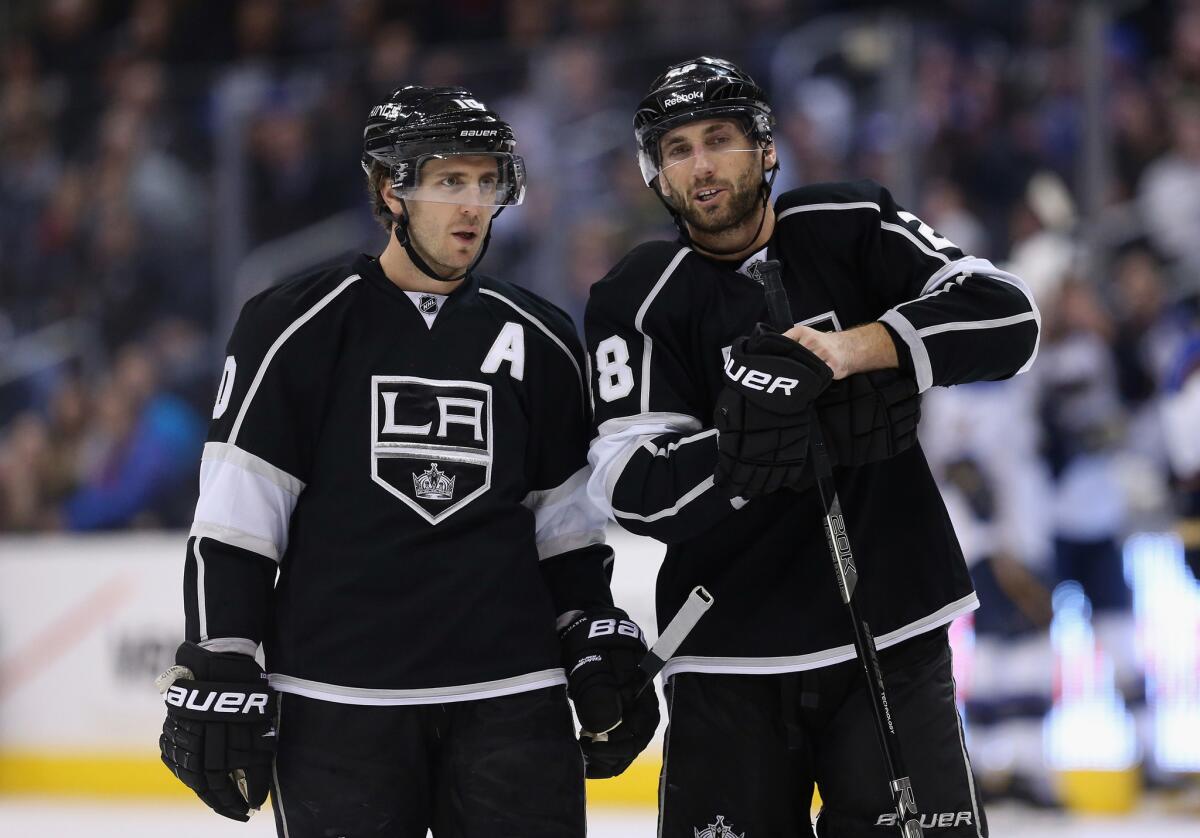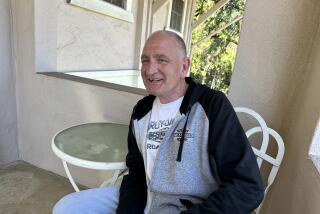Cases of former Kings Jarret Stoll and Mike Richards put spotlight on NHL drug policy

Former Kings Mike Richards (10) and Jarret Stoll (28) talk during a 2013 game against the Blues.
- Share via
For NHL enforcer Brian McGrattan, rock bottom wasn’t turning into a shell of a person, ravaged by drug and alcohol use, locking himself in a dark room for two days and turning off his cellphone to shut out the world.
Nor was it the final “four-day bender,” closing in on seven years ago, events lost forever in a cloud of substance abuse during a hazy spree.
It might have seemed to be the morning he woke up and made a tearful phone call to his mother, the emotional decision to get help. But that also was not the lowest point.
“Rock bottom is when you decide to stop drinking,” said McGrattan, who played in eight games with the Calgary Flames last season before signing a one-year deal with the Ducks in July, poised to start the season with their minor-league affiliate in San Diego.
“When you’re young, you don’t know what an alcoholic or a drug addict is,” he said in an interview with The Times shortly before training camps opened this month. “You just think you’re going out and having a good time and slowly the good times turn into dark time.
“That stuff eventually and slowly kills you. The sad thing about the disease is that the only way out is death. It’s very sad, very devastating and I was getting to that point.”
Harrowing tales of addiction and rehabilitation success such as McGrattan described are especially worth noting in the aftermath of a headline-making off-season, sparked by two drug-related cases involving Kings players.
Jarret Stoll, now with the New York Rangers, was arrested on suspicion of possession of cocaine and Ecstasy at the Wet Republic pool at the MGM Grand in Las Vegas in April. A single felony count was later reduced to two misdemeanors.
Center Mike Richards was arrested at the Canadian border in June and charged two months later with possession of a controlled substance, Oxycodone. Shortly after the arrest, the Kings moved to terminate his contract, citing a “material breach.”
Arrests weren’t limited to the Kings. In July, Ryan O’Reilly of the Buffalo Sabres was charged with impaired driving and leaving the scene of an accident after allegedly running his truck into a Tim Horton’s eatery in Canada, not far from London, Ontario.
More recently, Minnesota Wild assistant coach Darryl Sydor, whose NHL playing career started in Los Angeles with the Kings, was arrested in Minnesota in August for drunken driving, recording a blood-alcohol level more than three times the legal limit. He immediately entered the NHL/NHLPA Substance Abuse/Behavioral Health Program and is currently receiving treatment.
The disease of addiction is equal opportunity and the NHL is no exception. It has taken down goal-scorers and third-line grinders; small men and the biggest, most feared fighters in the league.
“It comes down to … it’s a disease that eventually wants to kill us,” says the now-retired Todd Fedoruk, who played with six NHL teams, including the Ducks. “It’ll use alcohol and drugs to get to that point. It comes down to the players’ willingness to make the change. All you have to do is have the resources for them.”
NHL drug testing policies have evolved over the years but aren’t nearly as stringent as those for some of the other major sports. Every aspect is collectively bargained with the NHL Players Assn.
“The NHLPA and the NHL made enhancements to the program as part of the current CBA,” NHLPA spokesman Jonathan Weatherdon said of the collective bargaining agreement, “and the sides annually review the program and have ongoing discussions about possible mid-term changes to strengthen and improve the program.”
With each new case comes further scrutiny.
“Any time there are situations that arise where players are charged with drug-related offenses, it’s not good,” NHL Deputy Commissioner Bill Daly said via email. “It’s not good for the players involved, not good for their teams, not good for the sport or for the image of the sport in the eyes of our fans.
“So, of course, when things like this happen, you have to look at what you are doing as a league and whether you can be doing anything better. Fundamentally, we think we have a very sound program that has served us and the players well for over 20 years now. We don’t have any concern with the discipline structure that is afforded to us pursuant to the terms of the program and the CBA.”
Players can expect to be tested during training camp and again during the season with no advance notice, tests being conducted on off days at their team’s training facility. Players are randomly selected during the regular season and playoffs. There is a league-wide maximum of 60 tests in the off-season, a tiny sampling for a 30-team league with more than 600 players.
Tests are conducted for drugs of abuse and performance-enhancing drugs, but in cases of drugs of abuse only an “abnormally” high test triggers action. It is flagged anonymously and doctors connected with the NHL/NHLPA program can contact the player.
“Where we and the PA are most focused is on the education and support elements of the program and making sure those elements are as strong as they can be,” Daly said.” And that’s where we are working on bolstering. That process carries with it a number of aspects, including, among other things: when, how and what we test for and what we use those tests for.
“But I’m not really in a position to get into more detail than that other than to say that recent events have caused us and the PA to focus on the issues and to see if there may be more effective ways to address them and/or to prevent them altogether.”
Failure can be used as an educational tool.
“I have a lot of experience in that field of what not to do,” said former NHL player Brantt Myhres, who was once banned by the league for numerous violations of the substance-abuse policy.
McGrattan, Myhres and Fedoruk — now clean and sober — have shared their stories with the media and will continue to do so with current NHL players.
“I’ve been like a 7/11 when it comes to talking,” Myhres said. “Always open. Not only for ex-players, but anybody.”
These are the men whose openness could help make a difference, considering the league can’t always be forthcoming. Privacy rules, concerns for the league’s image and legal issues — such as the Derek Boogaard case — can inhibit dialogue.
Boogaard died from what was ruled to be an accidental drug and alcohol overdose while recovering from a concussion at age 28. A posthumous examination of his brain showed that he had suffered from chronic traumatic encephalopathy.
In 2013, his family filed suit against the NHL, claiming that indiscriminate prescriptions for painkillers issued to Boogaard by Minnesota Wild and Rangers team physicians had led to his addiction. They also claimed that administrators of the substance-abuse program Boogaard attended knew he violated rules many times — including a series of failed drug tests in his final months — yet never disciplined or suspended him, as program rules dictate.
When Boogaard died in 2011, Myhres said he had sent proposals to the NHL and the NHLPA, aiming to create an in-house resource for players and coaching staffs.
He didn’t get traction until this summer. The NHLPA signaled an interest, but Kings General Manager Dean Lombardi made the move to hire him, creating a job focused on player assistance. Myhres joined the organization just before rookie camp and the team made his hiring official last week.
Myhres could be the ultimate detector of deceit. In an interview with The Times, he noted that “there’s nothing that these players can say to me that I haven’t done 100 times over.”
In John Branch’s book about Boogaard, “Boy on Ice,” Myhres talked about using hockey tickets to make friends with specimen collectors so they would not follow him to the restroom. He figured out how to store clean urine and how to make sure it was the right temperature before testers collected it.
“He would have cups of piss under his sink,” Fedoruk said. “That’s like an urban legend in the NHL.”
Only this one was true.
“He hurt a lot of people, a lot of organizations that were out to help him,” Fedoruk said of Myhres. “I’m sure they’re glad he’s doing what he is doing. That’s what is going to help him. That’s what I want to do. Get the message out [that] there’s a place to get help.”
As far as McGrattan and Fedoruk are concerned, every team should have a resource such as Myhres available. McGrattan noted that two of his former teammates, Rich Clune and Jordin Tootoo, are examples of those who also could give back after going through rehabilitation.
“I’m definitely an advocate for more,” Fedoruk said. “I think it’s a great thing that Brantt is doing. The hockey culture is going to tend to be one of coaches/management and players. There’s that disconnect and it will always be there.
“He is working for the organization on the players’ behalf. That’s still a hard thing to get around. The hockey community is an extremely tight group. There’s still that element of, ‘Keep your secrets, boys.’”
The summer of Richards and Stoll has provoked difficult questions within the Kings organization. Were there signs that were missed?
“You become almost masterful living a couple of lives, two, three lives,” Fedoruk said, speaking about his experiences. “All you’ve got to do is show up, put in some good work and don’t mess up too much at practice.”
Because of the confidential nature of the program, it isn’t always known to the team when a player enters it, especially in the summer. McGrattan said that he was once afraid of others finding out that he went into the program.
“Before,” he said, “I would have said, ‘I hope the team doesn’t find out.’ They’ll use it against you. That was before. Now I think everybody is more open-minded about it. With any guy going in now, I probably wouldn’t have a problem with any team finding out a player is going in for treatment.
“I think we can pave the way for other guys who have off-ice, alcohol, drug issues. ... It’s a lot easier for them to relate to us. If they want to go into the program or before anything happens, it’s easier for them to talk to anybody else.
“It’s an insurance policy to have guys available to keep guys in line or if a guy is struggling. There should be a guy in that position on every team.”
helene.elliott @latimes.com
More to Read
Go beyond the scoreboard
Get the latest on L.A.'s teams in the daily Sports Report newsletter.
You may occasionally receive promotional content from the Los Angeles Times.







